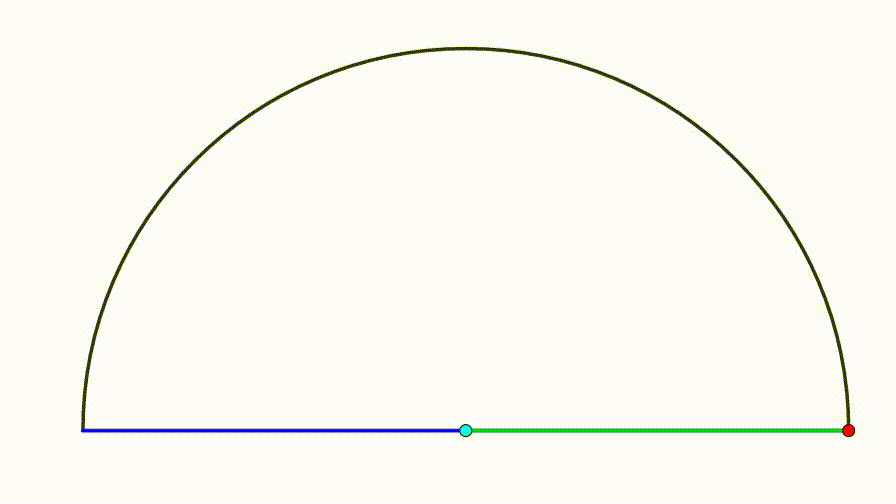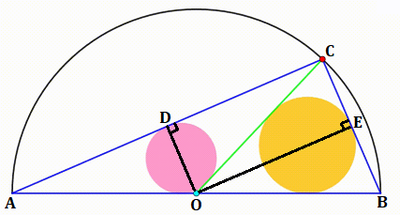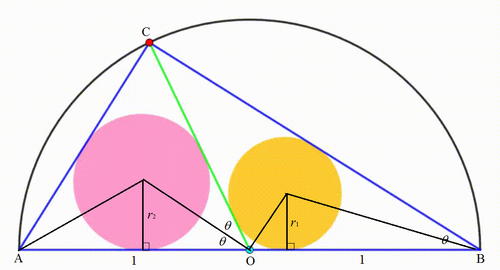Dynamic Geometry: P54
 The diagram shows a semicircle with radius
1
. A red point is freely moving along its arc. We use this point and the semicircle's diameter to draw a blue triangle. We draw the median of its base in green, dividing the blue triangle into two smaller triangles and we draw their incircles. When the ratio of their radii is equal to
3
2
2
5
, the sum of their radii can be expressed as
q
p
, where
p
and
q
are coprime positive integers. Find
p
+
q
The diagram shows a semicircle with radius
1
. A red point is freely moving along its arc. We use this point and the semicircle's diameter to draw a blue triangle. We draw the median of its base in green, dividing the blue triangle into two smaller triangles and we draw their incircles. When the ratio of their radii is equal to
3
2
2
5
, the sum of their radii can be expressed as
q
p
, where
p
and
q
are coprime positive integers. Find
p
+
q
The answer is 511.
This section requires Javascript.
You are seeing this because something didn't load right. We suggest you, (a) try
refreshing the page, (b) enabling javascript if it is disabled on your browser and,
finally, (c)
loading the
non-javascript version of this page
. We're sorry about the hassle.
4 solutions
Interesting solution !
I did it using coordinate geometry, where the point on the black semicircle has coordinate (x,y) with centre of semicircle as origin, then we can find area of big triangle as y, and each of the small triangle has area 0.5y since the green line is median, and then we can find the sides using distance formula, then we apply area = (semi perimeter)×inradius, and solve that equation along with x²+y² =1.
Draw the perpendicular bisectors of the legs of the triangle, and label the diagram as follows:

Let x = C D . Then by the Pythagorean Theorem on △ O D C , O D = O C 2 − C D 2 = 1 − x 2 , so the area of △ A O C is A △ A O C = 2 1 ⋅ A C ⋅ O D = 2 1 ⋅ 2 x ⋅ 1 − x 2 = x 1 − x 2 and the perimeter of △ A O C is P △ A O C = A C + A O + O C = 2 x + 1 + 1 = 2 x + 2 .
By Thales's Theorem , ∠ A C B is a right angle, so O D C E is a rectangle, and O E = D C = x and E C = O D = 1 − x 2 , which makes the area of △ B O C A △ B O C = 2 1 ⋅ C B ⋅ O E = 2 1 ⋅ 2 1 − x 2 ⋅ x = x 1 − x 2 and the perimeter P △ B O C = C B + O B + O C = 2 1 − x 2 + 1 + 1 = 2 1 − x 2 + 2 .
The inradius of △ A O C is then r △ A O C = P △ A O C 2 A △ A O C = 2 x + 2 2 x 1 − x 2 = x + 1 x 1 − x 2 and the inradius of △ B O C is r △ B O C = P △ B O C 2 A △ B O C = 1 − x 2 + 1 x 1 − x 2 .
If the ratio of the radii is 3 2 2 5 , then r △ A O C r △ B O C = x + 1 x 1 − x 2 1 − x 2 + 1 x 1 − x 2 = 1 − x 2 + 1 x + 1 = 3 2 2 5 , which solves to x = 1 7 8 .
Then r △ A O C = x + 1 x 1 − x 2 = 1 7 8 + 1 1 7 8 1 − ( 1 7 8 ) 2 = 8 5 2 4 and r △ B O C = 1 − x 2 + 1 x 1 − x 2 = 1 − ( 1 7 8 ) 2 + 1 1 7 8 1 − ( 1 7 8 ) 2 = 6 8 1 5 , so r △ A O C + r △ B O C = 8 5 2 4 + 6 8 1 5 = 3 4 0 1 7 1 , which means p = 1 7 1 , q = 3 4 0 , and p + q = 5 1 1 .
Application of half-angle tangent substitution reduces incircles in triangle problem into solving polynomial of t as shown in this solution.

Label the center of the semicircle O and the triangle A B C with A B being the diameter of the semicircle. Let the radii of the right and left circles be r 1 and r 2 respectively, and ∠ C B O = θ , then ∠ C O B = 1 8 0 ∘ − 2 θ , ∠ C O A = 2 θ , and ∠ C A O = 9 0 ∘ − θ .
Consider the segment O B ; we note that:
r 1 cot 2 ∠ C O B + r 1 cot 2 ∠ C B O r 1 cot ( 9 0 ∘ − θ ) + r 1 cot 2 θ r 1 ⋅ 1 − t 2 2 t + t r 1 r 1 ⋅ t ( 1 − t 2 ) 1 + t 2 = O B = 1 = 1 = 1 Let t = tan 2 θ . . . ( 1 )
Similarly,
r 2 cot ( 4 5 ∘ − 2 θ ) + r 2 cot θ r 2 ⋅ 1 − t 1 + t + r 2 ⋅ 2 t 1 − t 2 r 2 ⋅ 2 t ( 1 − t ) t 3 + t 2 + t + 1 = A O = 1 = 1 . . . ( 2 )
From ( 2 ) ( 1 ) :
r 2 t ( 1 − t 2 ) ( t 3 + t 2 + t + 1 ) r 1 ( 1 + t 2 ) ⋅ 2 t ( 1 − t ) r 2 ( 1 + t ) 2 2 r 1 1 6 ( 1 + t ) 2 2 5 ( 1 + t ) 2 1 + t ⟹ t = 1 = 1 = 1 = 1 6 2 5 = 4 5 = 4 1 Putting r 2 r 1 = 3 2 2 5
From ( 1 ) : r 1 = 1 + t 2 t ( 1 − t 2 ) = 6 8 1 5 . The sum of two radii r 1 + r 2 = ( 1 + 2 5 3 2 ) r 1 = 2 5 5 7 ⋅ 6 8 1 5 = 3 4 0 1 7 1 . Therefore p + q = 1 7 1 + 3 4 0 = 5 5 1 .
Nicely done.
1 2 3 4 5 6 7 8 9 10 11 12 13 14 15 |
|
1 2 |
|
Need to know :
For a triangle with side length a , b , c A r e a = r s where r is the radius of it's incircle and s = 2 a + b + c . . . . . . . . . . [ A ]
Let the diameter of the semicircle be A B , its center point be O and the other radius separating the two circle be O P
Let a = A P , b = P B and let the radius of the triangles formed be r 1 , r 2
From Apollonius theorem we get : a 2 + b 2 = 4 . . . . . . . . . . [ 1 ] Using [ A ] relation we get : 2 a b = r 1 ( 2 a + 1 ) = r 2 ( 2 b + 1 ) ⇒ r 2 r 1 = 2 a + 1 2 b + 1 = a + 2 b + 2 = 3 2 2 5 ⇒ 2 5 a − 3 2 b = 1 4 ⇒ a = 2 5 1 4 + 3 2 b . . . . . . . . . . [ 2 ] Putting this in [ 1 ] and simplifying we get 1 6 4 9 b 2 + 8 9 6 b − 2 3 0 4 = 0 Using Quadratic formula and the inequality : b > 0 we get b = 1 7 1 6 Putting this in [ 2 ] a = 1 7 3 0 Now in △ O P A and △ O P B we know all the sides
Hence we can find that : a r ( △ O P A ) = 2 8 9 1 2 0 a r ( △ O P B ) = 2 8 9 1 2 0 And we can also find the semiperimeters which are 1 7 3 2 , 1 7 2 5 respectively
Hence using [ A ] we can find r 1 = 6 8 1 5 r 2 = 8 5 2 4 ⇒ r 1 + r 2 = 3 4 0 1 7 1 ∴ A n s = 1 7 1 + 3 4 0 = 5 1 1
Note :